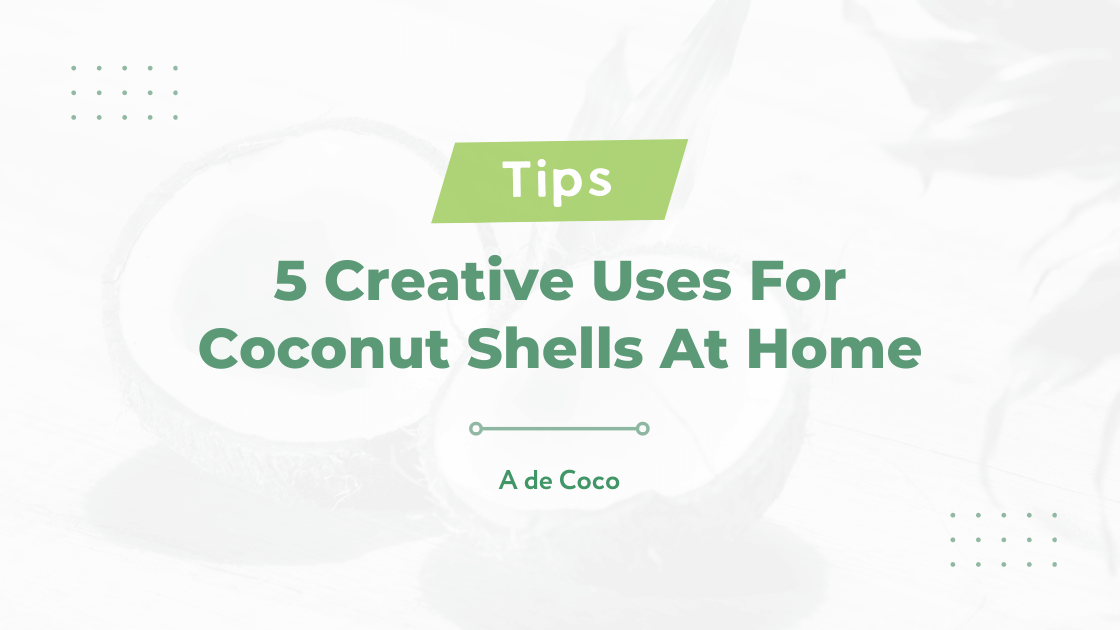Coconut shells, usually discarded and overlooked, can be transformed into versatile household items with just a bit of creativity.
This organic waste product, abundant and easily accessible, is a treasure trove of potential.
In a bid to promote sustainability and reduce landfill, upcycling coconut shells is a step towards eco-friendly living.
Upon deeper examination, you’ll find that they are durable, easy to carve and intriguingly attractive.
From decorative items to functional utensils, the possibilities are expansive.
This article aims to reveal and educate on the untapped potential of this natural resource.
- Coconut shells can be uniquely designed as small plant garden pots.
- Handmade bird feeders can be created using coconut shells.
- Coconut shells serve as natural soap dishes.
- Creative and decorative candle holders can be made from coconut shells.
- Coconut shells can be transformed into unique tropical-themed bowls.
There’s much more intriguing information stored for you in the coming sections. Let’s further explore the versatility of coconut shells, discussing upscale arts and craft projects, or how to utilize them for more home decor ideas.
In addition, we’ll tackle the environmental benefits of using coconut shells, detailing how they contribute to a more sustainable lifestyle.
Interesting facts about their durability and natural properties that make them suitable for such uses will also be part of the discussion.
Stay tuned to embrace a new perspective on the seemingly mundane but fascinating world of coconut shells.
Contents
Creative Uses For Coconut Shells At Home
1. Garden Pots for Small Plants
In Short: Coconut shells, known for their durability and moisture retention, make for sustainable garden pots for small plants, extending your eco-friendly approach to home decor. Transforming the shells involves cleaning and drying, creating drainage holes, applying sealant, adding compost, and setting up adequate sunlight and ventilation.
Coconut shells serve as effective and sustainable alternatives to traditional home and garden decors, particularly as charming garden pots for small plants.
These tropical delights can be adapted into handcrafted utensils with a simple touch of creativity. As plant containers, coconut shells not only provide a distinctive aesthetic appeal but also churn out multiple benefits.
As a highlight, coconut shells contain a high amount of lignin, which makes them extremely durable and resistant to degradation.
Their natural hardness and stability can withstand the harsh elements of nature, extending their usability for several years.
The dense fibers in coconut shells can also promote healthy plant growth. These fibers can absorb and retain moisture, allowing your plants to stay hydrated for more extended periods. For individuals with petite homes or apartments, using these compact vessels can be a space-saving gardening approach.
As an initial step to transform coconut shells into garden pots, it requires a thorough cleaning and drying process to reduce the decay rate and remove the distinctive coconut scent that may attract bugs.
The following are ways that you can adapt your coconut shells into eco-friendly garden pots:
- Drilling small holes at the bottom of the shells allows proper drainage and prevents waterlogging.
- Applying a protective organic sealant can maintain the shell’s aesthetics and longevity.
- The addition of rich compost or soil provides a healthy medium for your plants.
- Focused placement with adequate sunlight and ventilation, ensuring the growth and survival of your plants.
Beyond these practical tips, your creativity can shine through in personalizing your coconut pot. You can paint the exterior with colorful patterns or etch out unique designs for an artistic touch.
You can scale up this project, creating a stunning array of coconut plant pots to ornate your home and garden, while also embodying the principles of sustainability and recycling.
Moreover, coconut pots can house a variety of small plants, from herbs, succulents, to miniature flowers. As such, these coconut shell planters serve not only as functional garden pots but also as charming decorative accessories that add a tropical flair to your space.
Pro Tip: Coconut shells, having high amounts of lignin that make them durable and resistant to degradation, serve as an effective, sustainable alternative to traditional home and garden decors, particularly as garden pots for small plants, providing a distinctive aesthetic appeal and promoting healthy plant growth.
This unique and eco-friendly solution can inspire friends and family to engage in gardening and environmental conservation.
Let me tell you, when you next enjoy a refreshing coconut beverage, consider saving those shells and give them a second life as useful and beautiful garden pots for small plants.
2. Handmade Bird Feeder
In Short: Coconut shells can be creatively repurposed into handmade bird feeders, serving as eco-friendly additions to your garden and helping to feed local birds. Making such feeders is a simple DIY project, interesting to both children and adults, and involves a process of cleaning, drilling holes, tying a cord, filling the shell with birdseed, and hanging in your outdoor space.
One highly creative and environmentally-friendly way to utilize coconut shells is by transforming them into handmade bird feeders.
The inherent design of a coconut shell makes it a perfect vessel for holding birdseed and can serve as an excellent addition to your garden while also helping to feed local bird populations.
Creating a bird feeder out of a coconut shell does not require any complex tools or techniques, making it a fun and easy DIY project for adults and kids alike.
Eco-conscious homeowners would appreciate that this innovative idea promotes recycling and reducing waste by using a natural object that would otherwise go to trash.
Moreover, the rustic look of coconut shell bird feeders adds a touch of tropical charm to your outdoor living space.
Here are a few basic steps that you can follow to create your own coconut shell bird feeder:
- Clean and dry the coconut shell thoroughly. It is critical to ensure that the shell is free from oil and residual coconut meat.
- Drill holes on the top part of the shell and tie a cord or twine through the holes to create a hanging structure.
- Fill the shell with birdseed and securely hang it in your garden or balcony where birds can easily access it.
It should be noted that the placement of coconut shell bird feeders is crucial.
Choosing a quiet place where birds naturally flock and away from predators should encourage more birds to visit and use the feeder.
In addition, hanging the feeder in a location visible from your home will provide a delightful spectacle of visiting birds that you can enjoy watching during your free time.
Having a coconut shell bird feeder also provides an opportunity to observe different bird species and their behavior up close, which can be a fascinating and educational experience, especially for children.
Maintenance of these bird feeders is quite minimal as well.
The durable coconut shell can withstand varying weather conditions and can be easily cleaned and refilled when the food runs out.
Pro Tip: A handmade bird feeder made from a coconut shell is not only a creative and eco-friendly project, but it also serves a practical purpose in feeding local bird populations and adding tropical charm to your outdoor space.
In essence, a handmade bird feeder made from a coconut shell is far more than a mere garden decoration.
It is a testament to human creativity and resourcefulness, a practical application of the recycle and reuse principle, and a humble contribution to supporting local bird life.
3. Natural Soap Dish
In Short: Coconut shells can be creatively reused as a natural, durable, and stylish soap dish that incorporates a touch of nature into your bathroom. This DIY project contributes to sustainable living by reducing plastic waste, with coconut shells being 100% biodegradable and serving as a functional and unique bathroom accessory.
When speaking about artistic and environmentally-friendly uses for coconut shells, one cannot overlook the idea of a natural soap dish.
This is a creative and practical way to utilize coconut shells, effectively transforming a simple by-product into a functional and stylish accessory for your bathroom.
Incorporating a coconut shell soap dish introduces a touch of nature into your living space, encasing your preferred soap bars in a natural, durable holder.
The distinct pattern on these shells adds a nice organic touch compared to the commonly used plastic or ceramic soap dishes.
Additionally, the robust composition of coconut shells makes them highly durable and water-resistant, making it a perfect material to safeguard your soaps.
More importantly, the natural grooves on the coconut shell work effectively in draining the excess water, thus preventing your soap from getting mushy.
Despite the practicality and sustainability of using a coconut shell soap dish, it’s equally essential to emphasize how easy it is to create one.
Here are some simple steps on how to make a coconut shell soap dish:
- Firstly, take a clean coconut shell, and make sure the outer husk is removed.
- You will also need to polish the inside of the shell to make it smooth for the soap.
- Next, drill two or three holes at the bottom for drainage purposes.
- Finally, polish the shell with some coconut oil to seal it and give it a shiny, attractive look.
Therefore, these simple steps can assist you in crafting a functional and unique bathroom accessory.
Apart from being a simple DIY project, using a coconut shell as a soap dish also contributes towards your objective of maintaining a more sustainable lifestyle.
Unlike common soap dish materials like plastic, coconut shells are 100% biodegradable, reflecting positively on you as a conscious consumer.
Additionally, this small change in your lifestyle can make a significant contribution in reducing plastic waste, and furthering the cause of a plastic-free bathroom.
Over time, this valuable addition can become a conversation starter, reflecting your creativity, eco-consciousness, and style.
Thus, it’s clear to see that transforming a humble coconut shell into a soap dish is a simple yet brilliant way to combine creativity, functionality, and environmental accountability.
4. Decorative Candle Holders
In Short: Coconut shells can be converted into unique and eco-friendly decorative candle holders that enhance home décor. The crafting process involves cleaning, sizing, and polishing the shell, and filling it with wax – making it a creative, sustainable, and practical recycling activity.
As you explore new and creative uses for coconut shells in your home, consider their potential as decorative candle holders.
The natural, tough exterior of a coconut shell, when polished, can give a rustic yet sophisticated look to your décor.
Each coconut shell is unique in its size, shape, and patterns, which adds an element of individuality wherever they are placed.
A few well-made coconut shell candle holders can also become conversation starters when you have guests over.
The steps to creating these captivating pieces are not as complex as you might think.
First, the coconut shell must be cleanshed and dried thoroughly.
It is crucial that the entire husk has been removed, and any loose fragments are scraped off.
You should then proceed with cutting the shell to the desired size.
The inside of the shell should be sanded down to achieve a smooth finish.
Once these preparatory steps are completed, creating the actual decorative candle holder involves filling the shell with wax and inserting a wick.
Here is a step by step guide to making a decorative candle holder with a coconut shell:
- Choose a mature, well-dried coconut which will offer a sturdy base for the candle.
- Cut off the top of the shell to make it flat and leveled.
- Polish the shell both from inside and outside to give it a sheen.
- Melt some wax in a double boiler and insert a pre-wicked candle wick into it.
- Pour the wax into the shell, ensuring the wick is centered.
While the process requires some effort, you will be rewarded with a beautiful, eco-friendly candle holder that adds a unique touch to your home décor.
For an added natural touch, you could consider leaving the outside of the coconut in its rough, natural state.
You also have the freedom to experiment with different candle colors and aromas, for a truly personalized touch.
Beyond their aesthetic allure, coconut shell candle holders are also a brilliant way of recycling a commonly discarded item.
Pro Tip: Creating decorative candle holders from coconut shells is a creative, sustainable, and practical activity that can enhance your home décor and serve as a brilliant way of recycling commonly discarded items.
Each candle holder you make is a step toward more sustainable living, in addition to being a delightfully creative endeavor.
Hence, creating decorative candle holders from coconut shells is an activity that combines creativity, sustainability, and practicality.
5. Unique Tropical-Themed Bowls
In Short: Coconut shells can be creatively upcycled into unique, tropical-themed bowls, serving as sustainable decor and functional dishware for a variety of foods. Crafting these bowls is a straightforward DIY project that involves cutting, hollowing, cleaning, sanding, and polishing the shell, offering a blend of aesthetics, usability, and eco-friendly living.
When it comes to creative uses for coconut shells at home, crafting unique tropical-themed bowls is a standout choice.
The combination of their natural, rugged exterior finish, and polished interiors creates a beautiful and unique contrast.
These bowls come in handy for serving traditional tropical dishes and can also serve as a unique piece of decor.
In addition to being practical and aesthetic, making these bowls can be an exciting DIY project.
Also, if you’re opting for a more eco-friendly lifestyle, these coconut shell bowls can serve as a sustainable alternative to traditional bowls.
Here are some steps to create a fun and beautiful coconut shell bowl.
- Firstly, cut your coconut shell in half.
- The next step would be to hollow out the insides.
- Following that, you’ll need to clean the shell thoroughly, getting rid of remaining coconut meat and fibers.
- Then you need to sand the inside of the shell to smooth out any rough spots.
- Finish it by polishing the exterior to give it a glossy and appealing finish.
With just these few steps, you can create a natural, unique piece of artwork that can be put to practical use.
Another exciting characteristic of the coconut shell bowl is its versatility.
It can be used to serve a range of food types, from salads and desserts to traditional tropical dishes.
Keeping a set of these bowls in your kitchen cabinet can bring a piece of tropical paradise to your home, even if only in a small way.
Apart from their practical use, they also make for a great conversation piece when you have guests over.
Pro Tip: Coconut shells can be creatively used at home to craft unique tropical-themed bowls, serving as a sustainable alternative to traditional bowls, making it not only a practical and aesthetic piece but also an exciting DIY project.
Over and above their unique appearance and usability, these coconut shell bowls serve as a testament to upcycling, a great way to reduce waste and save the environment.
When you think about it, isn’t it amazing how something as simple as a discarded coconut shell can be transformed into an object of beauty and utility?
The Bottom Line
Undoubtedly, the versatility of coconut shells extends far beyond the culinary uses, offering eco-friendly and intriguing solutions for home-based functions.
Their durability, aesthetics, and environmentally friendly nature make them a valuable addition to your home decor, kitchen accessories, or gardening tools.
Harnessing these unconventional uses not only helps in sustaining the environment but also fosters creativity, uniqueness, and personal touch in-home projects.
The enduring charm of these coconut shells, therefore, transcends from being mere waste to becoming objects of utility, beauty, and sustainability.
Creatively incorporating them into home applications is a trendy, attractive and responsible manner to recycle and reuse these seemingly mundane objects.




